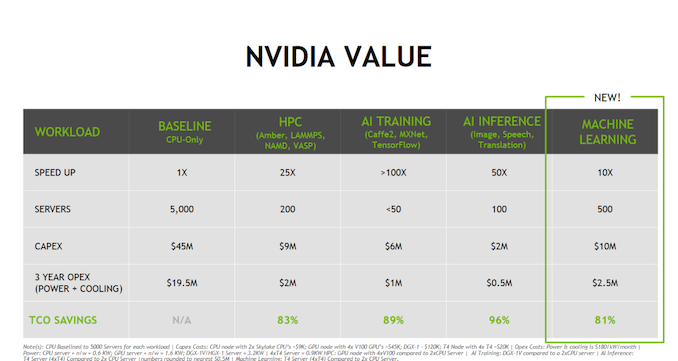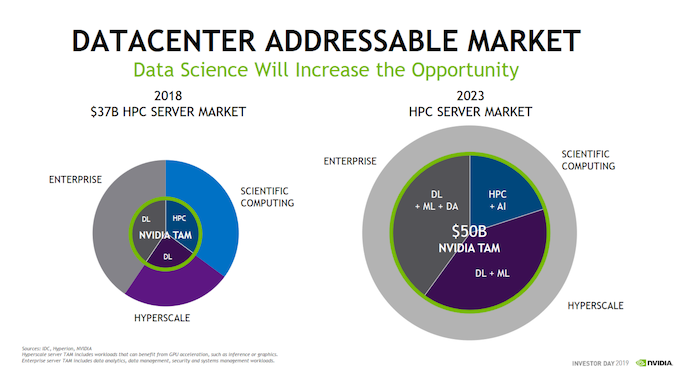Intel's Xeon Cascade Lake vs. NVIDIA Turing: An Analysis in AI
by Johan De Gelas on July 29, 2019 8:30 AM ESTWho Will Win the Next Enterprise Market?
At their last investors day, one of NVIDIA’s slides made it clear what the next battle in the enterprise space will be all about: data analytics. Note how an expensive dual Xeon “Skylake” Scalable is considered as baseline. That is quite a statement; reducing one of the latest Intel powered systems to a completely outperformed humble baseline.
NVIDIA’s entire business model revolves around the theory that buying expensive hardware like DGXs and Teslas is good for your TCO (“the more you buy, the more you save”). Don’t buy 5000 servers, buy 50 DGXes. Despite the fact that a DGX consumes 5 times more power, and costs $120k instead of $9k, you will be much better off. Of course, this is marketing at its best – or at its worst, depending on how you look at it. But even if the numbers are slightly exaggerated, it is a strong message: “from our deep learning stronghold to the Intel’s current growth market (Inference, HPC and machine learning), we will beat Intel by a large margin”.
Not convinced? This is how NVIDIA and IDC see the market evolving.
Currently the compute intensive or high-performance sub-market is about $37 billion out of a total $100 billion market. NVIDIA believes that this sub-market will double by 2023 and that they will be able to address $50 billion. In other words, the data analytics market – in a broad sense – will be almost half of the complete server market.
Even if this is an overestimation, it is clear that times are changing, and the stakes are very high. Neural networks are much better suited to GPUs, but if Intel can make sure that most of data pipeline runs better on CPUs and you only need a GPU for the most intensive and scalable neural networks, it will push NVIDIA back to a more niche role. On the other hand, if NVIDIA can accelerate a much larger part of the data pipeline, it will conquer markets that mostly belong to Intel and expand rapidly. And in the midst of this heated battle, IBM and AMD must make sure they get their share of the market. IBM will be offering better NVIDIA GPU based servers, and AMD will try building the right software ecosystem.












56 Comments
View All Comments
Bp_968 - Tuesday, July 30, 2019 - link
Oh no, not 8 million, 8 *billion* (for the 8180 xeon), and 19.2 *billion* for the last gen AMD 32 core epyc! I don't think they have released much info on the new epyc yet buy its safe to assume its going to be 36-40 billion! (I dont know how many transistors are used in the I/O controller).And like you said, the connections are crazy! The xeon has a 5903 BGA connection so it doesn't even socket, its soldered to the board.
ozzuneoj86 - Sunday, August 4, 2019 - link
Doh! Thanks for correcting the typo!Yes, 8 BILLION... it's incredible! It's even more difficult to fathom that these things, with billions of "things" in such a small area are nowhere near as complex or versatile as a similarly sized living organism.
s.yu - Sunday, August 4, 2019 - link
Well the current magnetic storage is far from the storage density of DNA, in this sense.FunBunny2 - Monday, July 29, 2019 - link
"As a single SQL query is nowhere near as parallel as Neural Networks – in many cases they are 100% sequential "hogwash. SQL, or rather the RM which it purports to implement, is embarrassingly parallel; these are set operations which care not a fig for order. the folks who write SQL engines, OTOH, are still stuck in C land. with SSD seq processing so much faster than HDD, app developers are reverting to 60s tape processing methods. good for them.
bobhumplick - Tuesday, July 30, 2019 - link
so cpus will become more gpu like and gpus will become more cpu like. you got your avx in my cuda core. no, you got your cuda core in my avx......mmmmmmbobhumplick - Tuesday, July 30, 2019 - link
intel need to get those gpus out quickAmiba Gelos - Tuesday, July 30, 2019 - link
LSTM in 2019?At least try GRU or transformer instead.
LSTM is notorious for its non-parallelizablity, skewing the result toward cpu.
Rudde - Tuesday, July 30, 2019 - link
I believe that's why they benchmarked LSTM. They benchmarked gpu stronghold CNNs to show great gpu performance and benchmarked LSTM to show great cpu performance.Amiba Gelos - Tuesday, July 30, 2019 - link
Recommendation pipeline already demonstrates the necessity of good cpus for ML.Imho benching LSTM to showcase cpu perf is misleading. It is slow, performing equally or worse than alts, and got replaced by transformer and cnn in NMT and NLP.
Heck why not wavenet? That's real world app.
I bet cpu would perform even "better" lol.
facetimeforpcappp - Tuesday, July 30, 2019 - link
A welcome will show up on their screen which they have to acknowledge to make a call.So there you go; Mac to PC, PC to iPhone, iPad to PC or PC to iPod, the alternatives are various, you need to pick one that suits your needs. Facetime has magnificent video calling quality than other best video calling applications.
https://facetimeforpcapp.com/